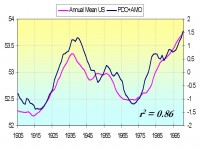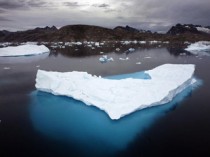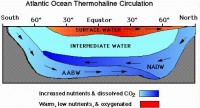
|
Aug 02, 2007
Synchronized Chaos: Mechanisms For Major Climate Shifts
By Science Daily
In the mid-1970s, a climate shift cooled sea surface temperatures in the central Pacific Ocean and warmed the coast of western North America, bringing long-range changes to the northern hemisphere. After this climate shift waned, an era of frequent El Ninos and rising global temperatures began.
Tsonis et al. investigate the collective behavior of known climate cycles such as the Pacific Decadal Oscillation, the North Atlantic Oscillation, the El ino/Southern Oscillation, and the North Pacific Oscillation. By studying the last 100 years of these cycles’ patterns, they find that the systems synchronized several times.
Further, in cases where the synchronous state was followed by an increase in the coupling strength among the cycles, the synchronous state was destroyed. Then. a new climate state emerged, associated with global temperature changes and El Nino/Southern Oscillation variability. The authors show that this mechanism explains all global temperature tendency changes and El Nino variability in the 20th century. See full story here.
This is a welcomed new peer-review work. Note agreement with an earlier ICECAP blog here.

Aug 01, 2007
The Sad Legacy Of David Suzuki
By Timothy Ball, Citizen Correspondent, Orato
A religious fervor for protecting nature has transformed Canada’s leading environmentalist into an emotional bully intolerant of scientists who don’t see things his way. Over the years I’ve heard and read statements by David Suzuki that are too often misleading or incorrect, especially about climate. He, and many like him, claim natural events are unnatural thus guaranteeing that they appear right. What he conveniently overlooks, and may have learned had he remained a scientist rather than becoming an activist, is that nature and climate frequently change dramatically and in very short time periods.
Read full story here.
Jul 30, 2007
Latest Scientific Studies Refute Fears of Greenland Melt
Marc Marano, EPW Blog
The July 27-29 2007 U.S. Senate trip to Greenland to investigate fears of a glacier meltdown revealed an Arctic land where current climatic conditions are neither alarming nor linked to a rise in man-made carbon dioxide emissions, according to many of the latest peer-reviewed scientific findings. Recent research has found that Greenland has been warming since the 1880’s, but since 1955, temperature averages at Greenland stations have been colder than the period between 1881-1955.
A recent study concluded Greenland was as warm or warmer in the 1930’s and 40’s and the rate of warming from 1920-1930 was about 50% higher than the warming from 1995-2005. One 2005 study found Greenland gaining ice in the interior higher elevations and thinning ice at the lower elevations. In addition, the often media promoted fears of Greenland’s ice completely melting and a subsequent catastrophic sea level rise are directly at odds with the latest scientific studies. These studies suggest that the biggest perceived threat to Greenland’s glaciers may be contained in unproven computer models predicting a future catastrophic melt.
As a representative of Environment & Public Works Committee Ranking Member, Senator James Inhofe (R-Okla.), I made the trek to the Arctic Circle with the Senate delegation (LINK) to the land the Vikings once farmed during the Medieval Warm Period.
Senators and their staff viewed majestic giant glaciers and icebergs in the Kangia Ice Fjord and in Disko Bay via helicopter, boat and on foot, during the three day 24 hours of daylight trip which began in the Arctic city of Kangerlussuaq, Greenland
See full blog here which includes links to recent studies refuting fears of rapid Greenland Melting.

Photo by Peter Knight
Jul 27, 2007
Four Climate Cycles of Recurring Deep and Surface Water Destabilizations on the Iberian Margin
Martrat et al. in Science, July 27, 2007
Note the important paper in Science by Belen Martrat, Joan O. Grimalt, Nicholas J. Shackleton, Lucia de Abreu, Manuel A. Hutterli, and Thomas F. Stocker that shows the importance in cyclical ocean circulation changes in historical climate change.
Centennial climate variability over the last ice age exhibits clear bipolar behavior. High-resolution analyses of marine sediment cores from the Iberian margin trace a number of associated changes simultaneously. Proxies of sea surface temperature and water mass distribution, as well as relative biomarker content, demonstrate that this typical north-south coupling was pervasive for the cold phases of climate during the past 420,000 years. Cold episodes after relatively warm and largely ice-free periods occurred when the predominance of deep water formation changed from northern to southern sources. These results reinforce the connection between rapid climate changes at Mediterranean latitudes and century-to-millennial variability in northern and southern polar regions.
Note the following courtesy of R. Behl CSU, Long Beach, CA

The major water masses in the deep ocean are differentiated by their temperature and salinity. These properties determine their relative densities, which in turn drive deep thermohaline circulation of the oceans. NADW = North Atlantic Deep Water. AABW = Antarctic Bottom Water. Modified from figure courtesy of Dr. Steve Hovan, Indiana University of Pennsylvania.
Jul 25, 2007
Falsification Of The Atmospheric CO2 Greenhouse Effects Within The Frame Of Physics
By Gerhard Gerlich, Institute ur Mathematische Physik, Federal Republic of Germany
The atmospheric greenhouse effect, an idea that authors trace back to the traditional works of Fourier 1824, Tyndall 1861 and Arrhenius 1896 and is still supported in global climatology essentially describes a fictitious mechanism in which a planetary atmosphere acts as a heat pump driven by an environment that is radiatively interacting with but radiatively equilibrated to the atmospheric system. According to the second law of thermodynamics such a planetary machine can never exist.
Nevertheless, in almost all texts of global climatology and in a widespread secondary literature it is taken for granted that such mechanism is real and stands on a firm scientific foundation. In this paper the popular conjecture is analyzed and the underlying physical principles are clarified. By showing that (a) there are no common physical laws between the warming phenomenon in glass houses and the fictitious atmospheric greenhouse effects, (b) there are no calculations to determine an average surface temperature of a planet, (c) the frequently mentioned difference of 33 C is a meaningless number calculated wrongly, (d) the formulas of cavity radiation are used inappropriately, (e) the assumption of a radiative balance is unphysical, (f) thermal conductivity and friction must not be set to zero, the atmospheric greenhouse conjecture is falsified.
|
|
|
|





